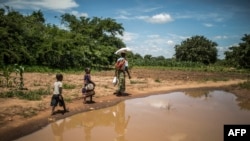Two senior U.N. officials are wrapping up their visit to Zambia to assess the country’s worst drought in 20 years, which affected some 8 million people and left at least 6 million at risk of food insecurity. The officials say communities affected by the drought need immediate humanitarian aid and food assistance.
Reena Ghelani, the U.N. assistant secretary-general, and climate crisis coordinator for the El Niño and La Niña response, and Eva Kadilli, UNICEF regional director for eastern and southern Africa, called for international solidarity to support the humanitarian response during their visit to Zambia.
Speaking in Lusaka Sunday, Ghelani said the country received less than normal rainfall, leaving hundreds of thousands of hectares of maize destroyed. This accounted for more than half of the country's cultivation of maize, which is a staple food in Zambia.
“That means there’s not going to be food on the table for many families, and they are not going to be able to purchase,” she said. “So we need to respond swiftly with assistance today. This might become the new normal so we need to prepare, as the president has said, for the future.”
The U.N. representatives met with government and local partners involved in ongoing efforts to address both the drought and a historic cholera outbreak that claimed more than 700 lives.
The U.N. officials also heard from communities and NGOs working on the frontlines of the humanitarian crisis.
Eva Kadilli, UNICEF regional director for eastern and southern Africa, told VOA that about 3 million of the people in need are children. She said those most vulnerable to the impact of a climate crisis are children, specifically those under 5. They were also impacted by COVID and cholera, she said.
“Now to drought … this has a huge toll on children, on communities and families but also mothers, pregnant women lactating women as well, young adolescent girls,” she said.
Felesia Manico, a small-scale farmer in Chongwe near the capital Lusaka, told VOA that the drought has been a nightmare as she lost hundreds of hectares of crops such as maize and various vegetables.
“Our fields dried up one month in we couldn’t get anything from all the inputs that we put in,” she said. “We invested quite a bit in seed and labor and also fertilizer and all the other requirements that come with farming.”
Another small-scale farmer, Sam Tembo, said he has lost all 40 hectares of maize field to the drought. He borrowed $5,000 from the bank.
“All my crops are gone and now I cannot afford any meals,” he said. “Already I have lost money investing in the crops … but nothing came out. I don’t know how I am going to feed the children as it is.”
Worsened by climate change and the El Niño weather pattern, the crisis threatens national food security as well as water and energy supply, Zambia’s President Hakainde Hichilema said recently.
Zambia is highly dependent on hydroelectric power as experts warn that the drought consequences could last until early 2025.
The U.N. mission follows a recent declaration by Hichilema of a state of emergency and national disaster, as 84 of the country’s 116 districts are affected by the prolonged drought.
The crisis could have regional implications as Zambia is a major maize exporter in the region.









